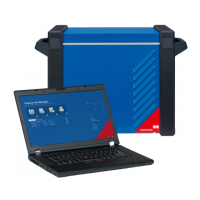CIBANO 500 PTM User Manual
182 OMICRON
Note: Connect the current clamp neutral directly to CIBANO 500 and not to the other end of the neutral
cable to avoid measurement errors due to the voltage drop on the cable. Alternatively you can supply
the motor from CIBANO 500 if you want or no station battery is available.
Measurement
To perform a measurement:
1. In the Settings and conditions area, enter the settings of the Timing test.
WARNING
Death or severe injury caused by high voltage or current possible
► If you use the station battery to supply the motor or the coils via CIBANO 500, do not connect
the cables to the station battery before they are connected to CIBANO 500.
► Always connect the cables first to grounded CIBANO 500 and then to the station battery.
Table 17-40: Settings of the Timing test
Setting Description
Coil supply
Supply source Select one of the following supply-source options:
• CIBANO 500 to supply the coils with CIBANO 500.
• External source to supply the coils with the source connected to VIN.
• Control board to supply the coils with a control-board switch.
1
Supply settings
2,3
Select a preconfigured coil supply setting from the asset data or select
Custom to enter custom settings.
Coil supply voltage Rated voltage of the coil supply
Click AC or DC for AC or DC coil supply voltage respectively.
Note: To perform the undervoltage trip and undervoltage close tests set the
coil supply voltage lower than the nominal voltage.
Test frequency Coil supply frequency (AC only)
Trip signal
4
Select whether the rising or falling edge of the trip signal opens the circuit
breaker.
Close signal
4
Select whether the rising or falling edge of the close signal closes the circuit
breaker.
Motor supply
Supply source Click CIBANO 500 to supply the motor with CIBANO 500.
Click External source if the motor is supplied from the station supply or
battery without any connection to CIBANO 500 or if the station battery is
connected to the VIN section and supplied, for example, via the B4 socket.
Note: We do not recommend supplying the motor with undervoltage. Doing
so does not provide any additional useful information and can cause
degradation of the motor operation over time.

